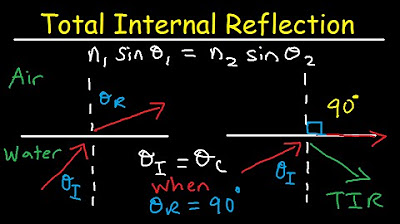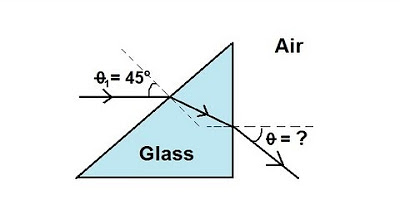Refraction of Light
TLDRThis educational video script introduces the concept of light refraction, demonstrating how light bends when it passes from one medium to another, such as from air to water or glass. The script uses a magic trick with a glass of water to visually illustrate refraction and explains the phenomenon with the help of a torch and a glass block. It defines refraction, discusses its everyday examples like a pencil in water or a swimming pool, and delves into the science behind it, including the change in light speed and the angles of incidence and refraction. The script concludes with an invitation to engage with the presenter's social media and website.
Takeaways
- 🌟 Light travels in a straight line, a phenomenon known as rectilinear propagation.
- 🧙♂️ A magic trick is introduced to demonstrate light bending, achieved by using a glass of water to refract the light.
- 🔦 The script uses a torch to illustrate how light travels in straight lines when in a single medium.
- 💡 Refraction of light is defined as the change in direction of light when it passes from one medium to another at an angle.
- 📚 The concept of refraction is explained using the example of a pencil appearing bent in water and a swimming pool appearing shallower.
- 🏺 Refraction occurs because the speed of light changes when it enters a denser medium, causing it to bend towards the normal line.
- 📐 The angle of incidence is the angle the incident ray makes with the normal, and the angle of refraction is the angle the refracted ray makes with the normal.
- 🔄 When light travels from a rarer to a denser medium, the angle of incidence is greater than the angle of refraction, causing the light to bend towards the normal.
- ↔️ Conversely, when light travels from a denser to a rarer medium, the angle of incidence is less than the angle of refraction, causing the light to bend away from the normal.
- 📍 In the special case of normal incidence, where light hits the medium perpendicularly, there is no change in direction despite a change in speed.
- 📝 The video concludes with an invitation to engage with the content through comments and subscribe to the channel for more educational content.
Q & A
What is rectilinear propagation of light?
-Rectilinear propagation of light refers to the natural tendency of light to travel in a straight line when it is in a homogeneous medium.
What is refraction of light?
-Refraction of light is the bending of light when it passes from one medium to another, changing its direction due to a change in speed.
Why does light bend when it enters a glass block filled with water?
-Light bends when it enters a glass block filled with water because the speed of light changes as it moves from air (a rarer medium) to water or glass (denser media), causing the light to refract.
What is the definition of refraction of light?
-Refraction of light is defined as the change in direction of light when it is traveling obliquely from one medium to another.
What are the everyday examples of refraction mentioned in the script?
-The everyday examples of refraction mentioned are a pencil appearing bent when placed in a glass of water and a swimming pool appearing shallower than it actually is.
What happens to the speed of light when it enters a denser medium like glass from air?
-When light enters a denser medium like glass from air, its speed decreases because glass is optically denser than air.
What is the relationship between the angle of incidence and the angle of refraction when light travels from air to glass?
-When light travels from air to glass, the angle of incidence is greater than the angle of refraction because light bends towards the normal as it slows down in the denser medium.
Can light bend away from the normal when it refracts?
-Yes, light can bend away from the normal when it refracts if it travels from a denser to a rarer medium, such as from glass to air, where the speed of light increases.
What is the special case of refraction when the angle of incidence is zero?
-The special case of refraction when the angle of incidence is zero is known as normal incidence, where the light travels perpendicular to the boundary between two media and does not bend, even though its speed changes.
What are the three angles involved in the process of refraction?
-The three angles involved in the process of refraction are the angle of incidence, the angle of refraction, and the angle between the normal and the refracted ray.
What is the difference between optical density and normal density of a material?
-Optical density measures how much a material can slow down light, whereas normal density refers to the heaviness or lightness of a material, typically measured as mass per unit volume.
Outlines
🌟 Introduction to Light Refraction Magic Trick
This paragraph introduces the concept of rectilinear propagation of light and sets the stage for a magic trick that demonstrates light bending. The host invites viewers to participate by using a glass of water to observe the refraction effect. The magic trick involves holding the glass in front of a screen with an arrow, which appears to change direction due to the bending of light, illustrating the phenomenon of refraction. The paragraph also introduces the topic of the video, which is the refraction of light, and mentions a torch as a tool to visualize light rays.
🔍 Understanding Refraction and Its Causes
This paragraph delves into the scientific explanation of light refraction, which occurs when light travels from one medium to another and changes its speed, causing it to bend. The host explains the difference between optically rarer and denser media, using air and glass as examples. The paragraph introduces key terms such as incident ray, point of incidence, normal, refracted ray, angle of incidence, and angle of refraction. It also discusses how the relationship between these angles changes depending on whether light is moving from a rarer to a denser medium or vice versa. Additionally, a special case of refraction is highlighted where light travels normally and does not bend, despite a change in speed.
📝 Engaging with Refraction through Top Three Questions
The final paragraph serves as a call to action for viewers to engage with the topic of refraction by attempting to answer the top three questions provided by the host. The host encourages viewers to share their answers and doubts in the comments section and promises to reply. The paragraph also serves as a reminder to subscribe to the host's YouTube channel, follow social media pages, and visit the Manoj Academy website for more educational content.
Mindmap
Keywords
💡Rectilinear Propagation
💡Refraction
💡Optical Density
💡Incident Ray
💡Normal
💡Angle of Incidence
💡Angle of Refraction
💡Optically Rarer Medium
💡Optically Denser Medium
💡Magic Trick
💡Pencil in Water
Highlights
Rectilinear propagation of light is demonstrated through a magic trick involving a glass of water.
The magic trick reveals the concept of refraction, where light changes direction when passing through different media.
A torch is used to illustrate how light travels in straight lines until it encounters a different medium.
Refraction is defined as the change in direction of light when moving obliquely from one medium to another.
The optical density of a material affects how much it slows down light, which in turn influences the degree of refraction.
Examples of refraction include a pencil appearing bent in water and a swimming pool appearing shallower.
The speed of light in air is approximately 3 x 10^8 meters per second, and it slows down when entering denser materials like glass.
The angle of incidence is greater than the angle of refraction when light travels from a rarer to a denser medium.
The terms incident ray, point of incidence, normal, and refracted ray are introduced to explain the mechanics of refraction.
When light travels from a denser to a rarer medium, it bends away from the normal, and the angle of incidence is less than the angle of refraction.
A special case of refraction occurs when light is incident normally on a medium, resulting in no change in direction despite a change in speed.
The concept of optical density is distinguished from normal density, focusing on a material's ability to slow down light.
The video concludes with an invitation to engage with the presenter's social media and website for further learning opportunities.
The presenter encourages viewers to try the magic trick with friends and explore the concept of refraction in everyday life.
Three top questions related to the topic of refraction are promised to challenge and engage the audience.
The video emphasizes the importance of understanding the principles behind the magic trick to appreciate the science of refraction.
The presenter's enthusiasm for bending light is likened to the bending of light itself in a playful conclusion to the video.
Transcripts
Browse More Related Video

Refraction and Snell's law | Geometric optics | Physics | Khan Academy

Refraction Explained

Snell's Law & Index of Refraction Practice Problems - Physics

Refraction of Light

Total Internal Reflection of Light and Critical Angle of Refraction Physics

Physics 52 Refraction and Snell's Law (3 of 11) Light Ray Through A Prism
5.0 / 5 (0 votes)
Thanks for rating: